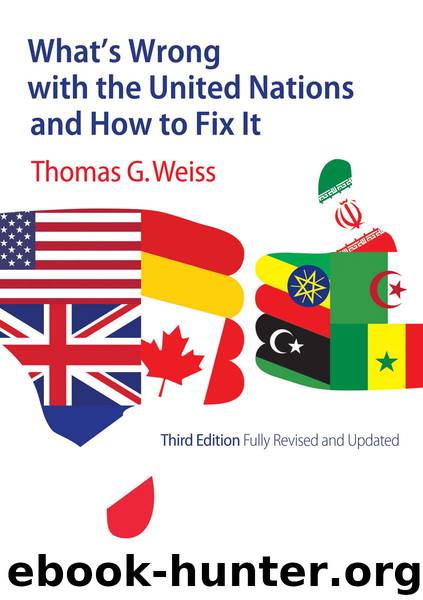Whats Wrong with the United Nations and How to Fix It by Weiss Thomas G.;

Author:Weiss, Thomas G.;
Language: eng
Format: epub
Publisher: Polity Press
Published: 2016-10-03T00:00:00+00:00
Gender Imbalance
One might have expected the UN to play a vanguard role in integrating women into its workforce compared with other institutions, and at least vis-à-vis its member states. While efforts have been made to achieve an equitable gender balance in the world body, however, the pace of progress has been glacial.15 Indeed, from the outset, women have had to challenge patriarchal norms and institutions, and much of their work on peace and security issues was separated from the UN’s mainstream activities in its early years.
Eleanor Roosevelt, first chair of the Commission on Human Rights, was a pioneer, and in February 1946, in her “Open Letter to the Women of the World,” she made a direct appeal for women to be involved in peace efforts, asserting that the UN provided a window of opportunity for them to do so.16 Some three decades later, at the first UN-sponsored world conference on women held in 1975 in Mexico City, governments signed the Declaration of Mexico, which proclaimed: “Women must participate equally with men in the decision making processes which help to promote peace at all levels.”17 That same year, the General Assembly called upon women to participate in the process of strengthening international peace and security in resolution 3519 (XXX).
Secretary-General Ban Ki-moon has a reputation as an advocate for the promotion of women to UN management posts, including the post of his special representative on sexual violence in conflict. Still, female peacekeepers remain scant, as do the negotiators of peace deals. At the beginning of the twenty-first century, women continue largely to be excluded from the front lines in this area, as illustrated by the paltry participation of women in UN peace operations at all levels. Table 4.1 shows the numbers of female military and police personnel in UN peacekeeping operations from 2000 to 2010. Over the last two decades, there has been some progress, with an overall increase in female participation—from 1 percent of uniformed personnel in 1993 to 3 percent of military and 10 percent of police in 2014. Those statistics, however, remain absurdly low, especially because for certain tasks—e.g., protection of displaced persons and the vast majority of rape victims—female peacekeepers could well be preferable to their male counterparts.18 While they constitute about 29 percent of civilian staff for missions, this is about the level they had attained some two decades ago.19
The representation of women in the professional and higher categories in the UN system is now over 40 percent (see Table 4.2). There has been steady improvement over the past decade and a half in gender balance at almost every level. At the P-1 and P-2 levels, there actually is now a gender imbalance in favour of women, because they occupy over half of those positions, which bodes well for the future as they get promoted.
Download
This site does not store any files on its server. We only index and link to content provided by other sites. Please contact the content providers to delete copyright contents if any and email us, we'll remove relevant links or contents immediately.
The Secret History by Donna Tartt(16627)
The Social Justice Warrior Handbook by Lisa De Pasquale(11489)
Thirteen Reasons Why by Jay Asher(7788)
This Is How You Lose Her by Junot Diaz(5774)
Weapons of Math Destruction by Cathy O'Neil(5037)
Zero to One by Peter Thiel(4824)
The Myth of the Strong Leader by Archie Brown(4789)
Promise Me, Dad by Joe Biden(4449)
Beartown by Fredrik Backman(4419)
Stone's Rules by Roger Stone(4416)
How Democracies Die by Steven Levitsky & Daniel Ziblatt(4399)
The Fire Next Time by James Baldwin(4343)
100 Deadly Skills by Clint Emerson(4079)
A Higher Loyalty: Truth, Lies, and Leadership by James Comey(4033)
Rise and Kill First by Ronen Bergman(4012)
The David Icke Guide to the Global Conspiracy (and how to end it) by David Icke(3883)
The Farm by Tom Rob Smith(3872)
Secrecy World by Jake Bernstein(3783)
The Doomsday Machine by Daniel Ellsberg(3731)
